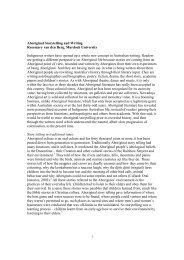Gallipoli, Kokoda and the Making of National Identity - [API] Network
Gallipoli, Kokoda and the Making of National Identity - [API] Network
Gallipoli, Kokoda and the Making of National Identity - [API] Network
You also want an ePaper? Increase the reach of your titles
YUMPU automatically turns print PDFs into web optimized ePapers that Google loves.
The <strong>Making</strong> <strong>of</strong> <strong>National</strong> <strong>Identity</strong><br />
... I fought at Eureka <strong>and</strong> <strong>Gallipoli</strong> <strong>and</strong> Lae,<br />
<strong>and</strong> I was a day too early (or was it too late?) to<br />
discover Coolgardie,<br />
lost my original Broken Hill share in a h<strong>and</strong> <strong>of</strong> cribbage,<br />
had <strong>the</strong> old man kangaroo pinch my shirt <strong>and</strong> wallet,<br />
threw fifty heads in a row in <strong>the</strong> big game at Kal,<br />
took a paddle-steamer seventy miles out <strong>of</strong> <strong>the</strong> Darling on<br />
a heavy dew,<br />
<strong>the</strong>n tamed a Gippsl<strong>and</strong> bunyip <strong>and</strong> sooled him on<br />
to capture <strong>the</strong> Tantanoola Tiger <strong>and</strong> Fisher’s ghost<br />
<strong>and</strong> became Billy Hughes’s secretary for a couple <strong>of</strong> weeks.<br />
Me, I outshore Jacky Howe, gave Buckley his chance ... 23<br />
Ian Mudie’s Australian embodies all that Australians have done in legend, literature<br />
<strong>and</strong> history: from writing about Clancy with a thumb nail dipped in tar to shooting<br />
through on a Bondi tram.<br />
Only about twenty per cent <strong>of</strong> Australians in 1997 were over <strong>the</strong> age <strong>of</strong> fiftyfive.<br />
As some <strong>of</strong> <strong>the</strong>se were also postwar migrants, perhaps less than fifteen per<br />
cent <strong>of</strong> Australia’s population could possibly remember events <strong>of</strong> 1939-1945.<br />
‘Australia Remembers’ but comparatively few Australians can draw on <strong>the</strong>ir own<br />
experiences <strong>and</strong> memories. When Con Sciacca in 1995 invited his audience to<br />
‘think back’ to events <strong>of</strong> fifty years ago, he was asking most <strong>of</strong> <strong>the</strong>m to think about<br />
what <strong>the</strong>y had absorbed second h<strong>and</strong>. The Australian War Memorial recognised<br />
<strong>the</strong> problem when it ran a visitor participation exercise as part <strong>of</strong> Australia remembers.<br />
It asked people to answer <strong>the</strong> question: ‘Where were you on VP Day 1945?’, but<br />
added: ‘If you were <strong>the</strong>re you’ll know. If you weren’t you can imagine’. The<br />
eighty-five per cent who had to imagine were dependent on <strong>the</strong>ir formal <strong>and</strong> informal<br />
ga<strong>the</strong>ring <strong>of</strong> information. The man in <strong>the</strong> pin stripe suit, felt hat in h<strong>and</strong>, dancing in<br />
<strong>the</strong> streets <strong>of</strong> Sydney was probably <strong>the</strong> common learnt image.<br />
The distinctions between national history <strong>and</strong> collective biography, between national<br />
history <strong>and</strong> collective memory, is all <strong>the</strong> more significant because <strong>of</strong> <strong>the</strong> emphasis<br />
that Australians now place on multiculturalism. Even John Howard in his ‘The<br />
Australia I Believe In’ said ‘I believe in an Australia which builds on <strong>the</strong> strengths<br />
<strong>of</strong> our multicultural society....’ 24 He was unlikely to say o<strong>the</strong>rwise. The national<br />
multicultural advisory council asserted: Some experiences which for many were<br />
previously fundamental to our sense <strong>of</strong> identity, for example our involvement in two<br />
world wars, are becoming less important with <strong>the</strong> passage <strong>of</strong> generations. 25 That<br />
was simply untrue during Australia remembers, <strong>and</strong> apparently untrue when<br />
measured against participation on recent Anzac Days. What many Australians, old<br />
<strong>and</strong> migrant, are prepared to accept is a multicultural present <strong>and</strong> unicultural past.<br />
Something like this has been going on in Australia for a long time. The children<br />
<strong>of</strong> migrants have taken over <strong>the</strong> history <strong>of</strong> <strong>the</strong> country <strong>the</strong>y live in: <strong>the</strong> children <strong>of</strong><br />
British migrants <strong>of</strong>, say, <strong>the</strong> 1920s placed <strong>the</strong>mselves in a national history that went<br />
back to gold <strong>and</strong> <strong>Gallipoli</strong>. The differences now are <strong>the</strong> numbers involved, <strong>the</strong><br />
diversity <strong>of</strong> backgrounds <strong>and</strong> <strong>the</strong> emphasis on cultural plurality in <strong>the</strong> nation <strong>of</strong> <strong>the</strong><br />
present. For those who want to shift attention from <strong>Gallipoli</strong> to <strong>Kokoda</strong> <strong>the</strong>re is a<br />
problem <strong>of</strong> deciding what it is that <strong>the</strong> Australians in 1942 fought for. At <strong>the</strong> time<br />
<strong>the</strong>y fought predominantly for <strong>the</strong> defence <strong>of</strong> <strong>the</strong>ir homel<strong>and</strong> — <strong>and</strong> that was enough<br />
157


![Gallipoli, Kokoda and the Making of National Identity - [API] Network](https://img.yumpu.com/31766380/10/500x640/gallipoli-kokoda-and-the-making-of-national-identity-api-network.jpg)
![Dream and Nightmare in William Gibson's ... - [API] Network](https://img.yumpu.com/49298598/1/184x260/dream-and-nightmare-in-william-gibsons-api-network.jpg?quality=85)

!['Fuck All Editors': The Ern Malley Affair and Gwen ... - [API] Network](https://img.yumpu.com/42446228/1/184x260/fuck-all-editors-the-ern-malley-affair-and-gwen-api-network.jpg?quality=85)
![Polona Petek - [API] Network](https://img.yumpu.com/40542952/1/190x245/polona-petek-api-network.jpg?quality=85)
![to download as a PDF. - [API] Network](https://img.yumpu.com/35170825/1/184x260/to-download-as-a-pdf-api-network.jpg?quality=85)
![Edward Koiki Mabo: The Journey to Native Title - [API] Network](https://img.yumpu.com/33197148/1/184x260/edward-koiki-mabo-the-journey-to-native-title-api-network.jpg?quality=85)
![Indigenous Knowledge and Pharmaceuticals - [API] Network](https://img.yumpu.com/24108846/1/184x260/indigenous-knowledge-and-pharmaceuticals-api-network.jpg?quality=85)
![Ferals: Terra-ism and Radical Ecologism in Australia - [API] Network](https://img.yumpu.com/13809010/1/184x260/ferals-terra-ism-and-radical-ecologism-in-australia-api-network.jpg?quality=85)
![Big Chief Little Wolf: Wrestling, Radio and Folklore in ... - [API] Network](https://img.yumpu.com/12204748/1/184x260/big-chief-little-wolf-wrestling-radio-and-folklore-in-api-network.jpg?quality=85)
![Dark Tourism and the Celebrity Prisoner - [API] Network](https://img.yumpu.com/4348795/1/184x260/dark-tourism-and-the-celebrity-prisoner-api-network.jpg?quality=85)